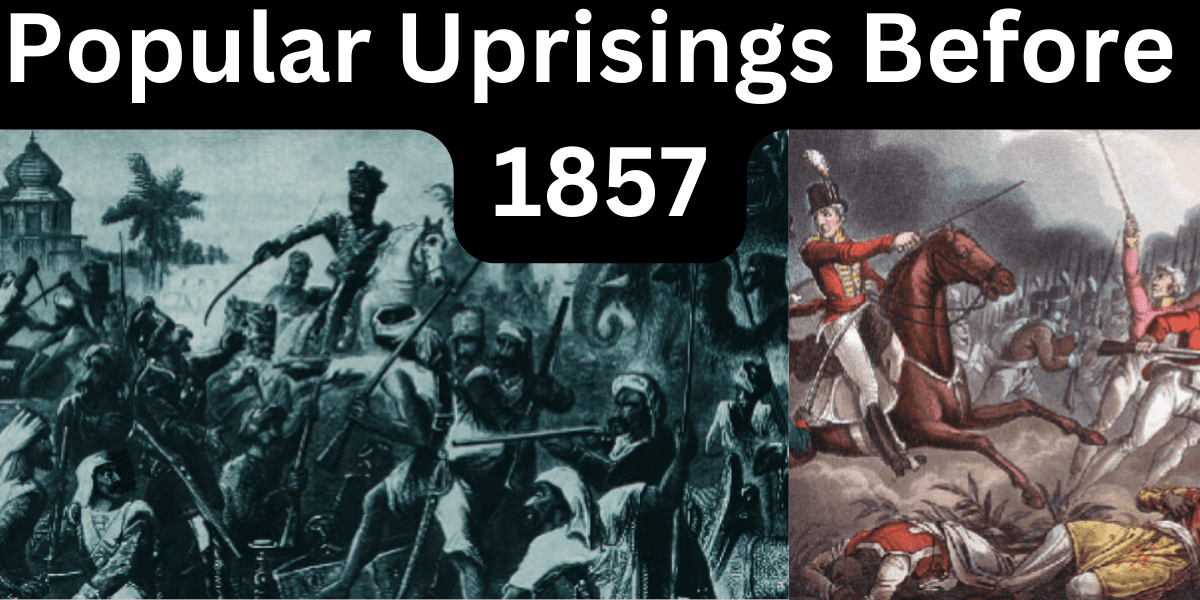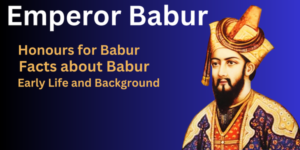Popular Uprisings Before 1857:
Prior to the Indian Rebellion of 1857, also known as the First War of Independence, a number of popular uprisings and rebellions occurred throughout India. These uprisings were frequently motivated by a combination of economic problems, cultural and religious grievances, and hatred of British colonial policies. While each rebellion had its own set of causes and characteristics, they all indicated a growing discontent and resistance to British rule in India. These uprisings had a profound impact on the terrain of Indian resistance to colonialism, setting the framework for the bigger rebellion that occurred in 1857.
| Revolt Name | Year | Place | Leaders | Reasons | Significance | |
Bengal Rebellion | 1763 | Bengal | Mritunjay Chowdhury, Rani Lakshmibai | High taxes, famine | Challenged British authority in Bengal | |
Sanyasi Uprising | 1763-1800 | Various locations across India | Sanyasis and Fakirs | Interference in religious practices, economic hardship | Highlighted religious and economic motivations for rebellion | |
Chuar Rebellion | 1766-1772 | Bengal | Jagannath Singh | Exploitation by Zamindars | Showcased resentment against land policies | |
Revolt in Midnapore and Dhalbhum | 1766-1774 | Bengal | Jagannath Singh | Exploitation by Zamindars | Highlighted resistance against land policies in Bengal | |
Mysore War | 1767-1799 | Mysore & Southern India | Hyder Ali, Tipu Sultan | British expansion in southern India | Showcased regional opposition to colonial expansion | |
Revolt of Moamarias | 1769-1799 | Assam | Various Moamarias | Expansionist policies of Ahom kingdom | Showcased internal conflicts within the Ahom kingdom | |
Picketing | 1776-1777 | Bengal | Sanyasis and Fakirs | Interference in religious practices | Showcased religious opposition to British rule | |
Paharias Rebellion | 1778 | Jharkhand | Tribal communities | British expansion, disruption of traditional way of life | Demonstrated tribal resistance against colonial intrusion | |
Velu Nachiyar’s Rebellion | 1780 | Sivaganga, Tamil Nadu | Rani Velu Nachiyar | British occupation of Sivaganga | Highlighted female leadership in early resistance | |
Civil Uprisings in Gorakhpur, Basti, and Bahraich | 1781 | Uttar Pradesh | Peasants | High taxes, famine | Demonstrated peasant resistance against economic hardship | |
Revolt of Raja of Vizianagaram | 1794 | Andhra Pradesh | Raja of Vizianagaram | British interference in internal affairs | Highlighted resistance from regional rulers | |
Polygar Wars | 1799-1805 | Tamil Nadu | Various Polygars | British land revenue demands | Showcased opposition to colonial economic policies | |
Revolt of Palayakkarars | 1799-1805 | Tamil Nadu | Various Polygars | British land revenue demands, loss of autonomy | Highlighted resistance from local chieftains in southern India | |
Vellore Mutiny | 1806 | Vellore, Tamil Nadu | Sepoys of East India Company | Changes in uniforms and religious regulations | Exposed discontent within the colonial military | |
Kutch or Cutch Rebellion | 1816-1819 | Gujarat | Rao Lakhmirji Aaiya | British imposition of tribute | Demonstrated resistance from princely states | |
Paika Rebellion | 1817 | Odisha | Bakshi Jagabandhu | Abolition of traditional zamindari system | Demonstrated resistance to changes in land ownership | |
Khond Uprisings | 1818-1882 | Odisha, Andhra Pradesh | Tribal communities | British interference in tribal customs, exploitation by outsiders | Demonstrated sustained tribal resistance against colonial control | |
Bhil Revolts | 1818-1832 | Western India | Tribal communities | British expansion, disruption of traditional way of life | Showcased widespread tribal resistance against colonial encroachment | |
Ramos Uprising | 1824 | Kanpur, Uttar Pradesh | Golam Kayum Ramos | British recruitment policies, unfair treatment | Showcased dissatisfaction among marginalized communities | |
Koli Risings | 1824-1829 | Maharashtra | Tribal communities | British interference in tribal customs, exploitation by moneylenders | Demonstrated tribal resistance against colonial control and exploitation | |
Ramosi Risings | 1822-1824 | Maharashtra | Tribal communities | British land policies, exploitation by outsiders | Showcased tribal resistance against land alienation and oppression | |
Ahom Revolt | 1828-1839 | Assam | Gamani Raja Manu Singh | British interference in Ahom administration | Showcased resistance against colonial control in Assam | |
Khasi Uprising | 1829-1833 | Meghalaya | Tribal communities | British expansion, imposition of taxes | Demonstrated tribal resistance against colonial intrusion and economic exploitation | |
Kol Uprising | 1831-1832 | Jharkhand | Birsa Munda | British land policies, exploitative moneylenders | ||
Koya Revolts | 1832 – 1842 | Eastern Ghats, Andhra Pradesh | Various tribal leaders | British land policies, exploitation by zamindars | Demonstrated tribal resistance against land alienation and exploitation | |
Singphos Rebellion | 1839 – 1842 | Upper Assam | Various Singpho chiefs | British expansion and interference in internal affairs | Showcased tribal resistance against colonial expansion in northeastern India | |
Santal Hull Rebellion | 1855 – 1856 | Eastern India (Santhal Parganas) | Sidhu and Kanhu Murmu | British land policies, oppressive landlords | Highlighted tribal resistance against exploitation and land alienation | |
Civil Rebellion in Awadh | 1857 | Awadh region | Maulvi Ahmad Shah | British annexation of Awadh | Showcased local support for the Sepoy Mutiny of 1857 | |
Rising at Bareilly | 1857 | Bareilly, Uttar Pradesh | Khan Bahadur Khan | British rule, support for the Sepoy Mutiny | Demonstrated widespread support for the rebellion in different regions | |
Waghera Rising | 1857 | Satara district, Maharashtra | Dada Nana | British rule, support for the Sepoy Mutiny | Showcased local uprising and support for the wider rebellion in western India | |
Munda Rebellion | 1899 – 1900 | Chota Nagpur plateau, Jharkhand | Birsa Munda | Religious interference, land alienation | Advocated for religious and political freedom for the Munda tribe | |
Moplah Uprisings | 1921 – 1929 | Malabar region, Kerala | Various leaders | British policies, religious tensions | Contested land ownership and religious suppression, showcased complex socio-political issues | |
Narkelberia Uprising | 1924 | Sundarbans, West Bengal | Tribal communities | British forestry policies, resource exploitation | Demonstrated tribal resistance against environmental degradation and resource control | |
Surat Salt Agitations | 1930 | Surat, Gujarat | Mahatma Gandhi | British salt laws | Promoted non-violent civil disobedience against colonial rule | |
Popular Uprisings Before 1857 About Frequently Asking Questions:
What were the early rebellions against British rule?
- Fakir Uprising (1763-1764):Led by Majnu Shah, a mendicant, against oppressive revenue policies in Bengal. Highlighting religious and socioeconomic concerns, it showcased early resistance to the East India Company’s exploitative practices.
- Sanyasi Rebellion (1760s-1800s):Primarily Hindu ascetics and peasants in Bengal challenged restrictions on pilgrimage and land dispossession by zamindars and the Company. It demonstrated widespread discontent against religious interference and economic exploitation.
Which was the first rebellion against British Empire?
- India’s 1857 Sepoy Mutiny: Arguably the first large-scale revolt within India against British rule, though primarily by sepoys and not necessarily unified for national independence.
- American Revolution (1775-1783): Preceded the formalized “British Empire” but remains a significant challenge to British colonial power.
What was the Popular Uprisings Before 1857 against the British?
- Fakir Uprising (1763-1764): Led by Majnu Shah, a mendicant, against oppressive revenue policies in Bengal. Highlighting religious and socioeconomic concerns, it showcased early resistance to the East India Company’s exploitative practices.
- Sanyasi Rebellion (1760s-1800s): Primarily Hindu ascetics and peasants in Bengal challenged restrictions on pilgrimage and land dispossession by zamindars and the Company. It demonstrated widespread discontent against religious interference and economic exploitation.
What were the main causes of the early rebellions against the British in India?
- Annexation of Oudh and Jhansi, treatment of Nana Sahib caused discontent. High land revenue, classified as rent, burdens farmers and causes rural distress.
- Muslims face marginalization in public service and education. Interfering with religious rituals and the oiled cartridge issue enraged both Hindus and Muslims.
- British policies upended the established economic foundations, resulting in poverty and rural indebtedness. Policies like the ‘Doctrine of Lapses’ reduced the power of the Indian rulers and made them resent the British.
- Resentment arose as a result of widespread corruption, racist views and distant British control. Fears that British actions and missionary activities would erode cultural and religious values.
Who were some of the key leaders of the early rebellions against the British?
The most important leaders the early rebellions against the British Majnu Shah, Rani Velu Nachiyar,Bhabani Pathak, Tilka Manjhi,veerapandiya Kattabomman, Marudu brothers, Puli Thevar ,Mavelinkara Velu Thampi Dalawa,Dhundhar Khan, Nana Sahib,Pazhassi Raja, Hyder Ali ,Tipu Sultan , Tantia Tope , Man Singh, Kunwar Singh.
What were the outcomes of these early rebellions?
- India would be governed in the name of the British King by a Foreign Secretary assisted by the Council of India. The East India Company’s Court of Directors and Board of Control were abolished, making the Crown and Parliament responsible for the administration of India.
- The separate army of the East India Company was abolished and merged with the state army.
- The Declaration ratified the treaties entered into by the Company with Indian princes, promised to respect their rights, dignity and honour, and disavowed any ambition to expand British possessions in India.
- Aimed at addressing the lack of Indian representation in the Legislative Council of 1853 that had led to the Crisis, the new Council included Indian appointments.
How did the British respond to these rebellions?
To quell future uprisings, the British used military force, severe reprisals, and punitive measures such as mass executions, property seizure, and the imposition of harsher control and monitoring. They also used divide-and-rule techniques to discourage resistance and practiced indirect rule through local collaborators. British stories from the time tended to portray Hindus and Muslims as religious fanatics, and they also saw Indian violence as a basic inclination rather than a response to tyranny
What impact did these rebellions have on the Indian independence movement?
The early rebellions against British rule in India laid the foundation for the Indian independence movement by fostering a spirit of resistance, unity, and nationalism among Indians, inspiring future leaders and movements in the struggle for independence. the rebellion proved to be an important watershed in Indian and British Empire history. It led to the dissolution of the East India Company, and forced the British to reorganize the army, the financial system, and the administration in India, through passage of the Government of India Act 1858.
What were the causes and consequences of the Sanyasi Rebellion?
- Reasons for revolt:
- Famine: The 1770 Bengal famine caused migration and economic suffering.
- Economic Policies: British policies were perceived as oppressive, resulting in rebellion.
- In 1771, 150 unarmed sanyasis were killed under the orders of Warren Hastings. The Sanyasi uprising went on for about 50 years and was suppressed completely only in the 1820s.
What role did Mangal Pandey play in the Sepoy Mutiny?
Mangal Pandey played an important role in the Sepoy Mutiny of 1857. He served as a sepoy (soldier) in the British East India Company’s army and is best known for inciting the uprising against British authority. On March 29, 1857, Pandey attacked and injured British officials in Barrackpore, near Calcutta (Kolkata), protesting the use of cow and lard-smeared bullets to offend Hindu and Muslim soldiers. Pandey’s act of disobedience inspired widespread discontent among Indian soldiers, resulting in a significant insurrection against British rule known as the Indian Rebellion of 1857, or the First War of Independence.
How did Velu Nachiyar challenge British rule in Sivaganga?
- Velu Nachiyar challenged British rule in Sivaganga by leading a rebellion against them in 1780, recapturing the fort of Sivaganga with the help of her army and allies, the Marudu brothers, and securing her position as queen.
- When Velu Nachiyar ascended the throne, Chinna Maruthu was appointed as adviser and Big Maruthu as commander. He faced further British invasions.




